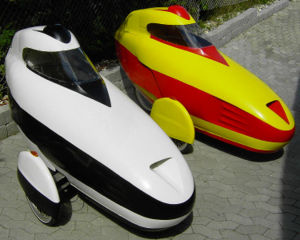Automated transport systems/Light, shared urban vehicles
Imagine a city with clean air free of the noise of engines, where you can get from anywhere to anywhere at 50mph (80km/h) or more without any danger of death, where the problems of traffic and parking are fully solved. This is entirely feasible with technology that has been around for many years; all we must do is eliminate the gross inefficiencies inherent in using private cars for urban commutes.
Small, light vehicles
If you look at the cars choking up city streets at rush hour, you will notice that over 75% of them are carrying only one passenger. Yet that one passenger is using a vehicle that weighs more than a ton and is over 3m long and 1.5m wide. To travel, you really only need something the size and weight of a bicycle and to travel in luxury you need something about the size of an armchair. If we reduce the amount of road-space per traveller from a car-footprint to an armchair-footprint, we increase the capacity of the roads four or five times. This in itself would almost entirely eliminate traffic congestion. If these small vehicles are driven by sophisticated AI capable of driving close together at speed, safely weaving in and out of other moving vehicles, then congestion will certainly be a thing of the past. This would allow vehicles to move around cities at, say, 50mph (80km/h). By comparison, the average speed around London is just 12mph (19km/h) [1]
Cars are designed to be able to travel hundreds of miles carrying five people and a full boot. Using such a vehicle to travel 5 miles carrying one person and a briefcase is like hiring the Trojan army to solve your 6-year-old son's bullying problem; it is excessive. Yet this is exactly how we use our cars the majority of the time: 77% of Americans drive cars to work with no passengers[2], 55% of car journeys in the UK are under 5 miles[3] and 49% of those in the US are under three miles[4]. Using cars for these journeys represents a huge waste of energy and space and causes the aggravation of parking and traffic - which are a huge waste of time. We can reclaim this if we make these short urban commutes in vehicles like:
- Bicycles
- Velomobiles
 .
. - E-bikes
 - bicycles assisted by electric motors.
- bicycles assisted by electric motors. - Electric scooters like RoboScooter
- Tiny electric cars or enclosed electric motorcycles built for one or two passengers, such as the Audi Snook or the MIT City Car.

Vehicle sharing schemes
Cars spend 96% of their time parked. That is to say, they spend 96% of their time wasting space. If we can find a way to reduce this to, say, 50% of the time, we would reclaim huge chunks of our cities now devoted to parking. This can be achieved by sharing vehicles so that when one person parks a vehicle, another person can come along and use it. This can be done either by leaving the vehicle at a shared dock, or, if this is not convenient, having a wireless transmitter that allows people to have the location of the nearest vehicle sent to them by SMS (as the bicycle-sharing scheme in Berlin currently does).
The bicycle sharing scheme in Lyon achieves 10-15 uses per bicycle per day[5], while in Paris the bikes are taken out 8-10 times per day[6]. Compared to privately-owned cars, which are used perhaps 3 times a day, this is much less wasteful of space and of vehicles themselves.
Because these vehicles are much smaller than cars, the amount of city space needed for parking can be reduced from a car-footprint 96% of the time, to an armchair-footprint 50% of the time — about a nine-fold decrease.
 and there is no reason the same model cannot be extended to other light, urban vehicles. The winner of the 2009 Buckminster Fuller challenge was a proposal for a fleet of shared small electric cars and electric scooters which would be docked at points around a city (where their batteries charge). There are plans to bring this in for several cities[7] and commercialization is planned for late 2012 [8].
and there is no reason the same model cannot be extended to other light, urban vehicles. The winner of the 2009 Buckminster Fuller challenge was a proposal for a fleet of shared small electric cars and electric scooters which would be docked at points around a city (where their batteries charge). There are plans to bring this in for several cities[7] and commercialization is planned for late 2012 [8].
(A rather more futuristic extension of this idea is also possible — rather than going to pick up a parked vehicle, what if you use your phone to get it to come to you? This would be possible with current autonomous vehicle technology. If the technology reaches this level of sophistication, it will be equivalent to a road-based PRT system.)
